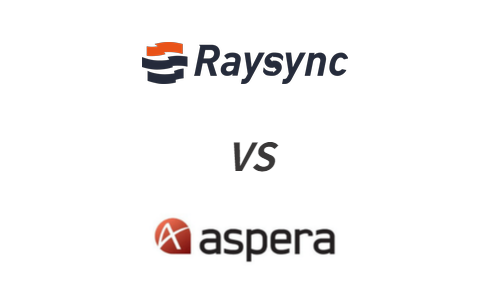[2024] How to Ensure the Safe Transmission of Large File Data?
January 3, 2024At present, the amount of file-type data in enterprises has increased sharply, and many enterprises usually use conventional methods such as email, IM tools, FTP, and network disks for file transfer. When the file capacity increases and the network environment deteriorates, the efficiency of file transmission and data exchange is low, and the security is poor. If the file is larger, usually a lower method such as express hard disk is used, which cannot meet the requirements of enterprises to obtain files in time. Seriously affect the overall operating efficiency of the enterprise.

Besides, the use of the above-mentioned traditional transfer methods is too decentralized, which is not conducive to centralized management of enterprises. In the era of cloud computing, enterprises currently have more and more service nodes and storage nodes, and data flow requirements based on business processes and hybrid cloud architecture are also increasing. The lack of an effective file transfer management platform is undoubtedly a major pain point. So what transfer methods do companies generally use to transfer large files?
How to Ensure the Safe Transmission of Large File Data?
1. CDN Technology
CDN: Content Delivery Network (Content Delivery Network). By adding a new network architecture to the existing network, it is mainly composed of two parts, divided into two parts: the center and the edge. The center refers to the CDN network management center and the DNS redirection resolution center, which is responsible for global load balancing, and the equipment system is installed in the management central computer room, edge mainly refers to remote nodes, the carrier of CDN distribution, mainly composed of cache and load balancer. Choose to publish the content of the site to the "edge" of the network closest to the user, so that the user can obtain the desired content nearby, thereby improving the response speed of the user to the site to a certain extent.
The data requirements of CDN are only independent documents (software, modules, files) or "independently replaceable" document parts.
2. Transmission Technology Based on FTP Protocol
FTP (File Transfer Protocol) is the abbreviation of the File Transfer Protocol. FTP allows files to be shared between hosts and is used to control the two-way transmission of files on the Internet. It is a C/S system. FTP uses different port numbers to transfer different content, and different TCP connections are established. First, use TCP to generate a virtual connection for transferring control information, and then generate another connection for data transmission. Combined with the FTP protocol, it can use file (compression/decompression) or file (fragmentation/assembly), file verification, and other technologies, and can also transfer large files. FTP transfer software such as (FileZilla) also can manage users, block or filter designated IP addresses, port, control user upload and download speed, detailed transmission history, and log, and can also carry out an encrypted transmission of data. It has the advantage of ensuring transmission security and protecting personal privacy.
3. Transfer Files Based on Middleware
Use MQ, MT, and other middleware to transfer files, with data compression, large file transfer, and breakpoint resumable transfer. The transfer of large files uses BlobMessage, which uses fileserver to transfer efficient processing. Message middleware technology has two core functions: asynchronous and decoupling. These two core functions improve the working efficiency of the application system as a whole, enhance the usability, stability, and scalability of the system, and can realize the safe and reliable transmission of large files.
4. IM Instant Messaging Technology
Most of the Instant Messenger (IM) technology is based on TCP/IP and UDP for communication, while TCP/IP and UDP are communication transmission protocols based on the lower-level IP protocol. The former is through the form of a data stream, after dividing and packaging the transmitted large file data, through the virtual-circuit connection established between the machines, a continuous, two-way transmission protocol that strictly guarantees the correctness of the data is carried out, mainly Reliable transmission is achieved through mechanisms such as checksum sequence number, confirmation response, time-out retransmission, connection management, and window sliding. The latter is a connectionless transport layer protocol in the OSI reference model, which is mainly used for data that does not require data In the transmission of packets arriving in sequence, the checking and sorting of the packet transmission sequence is completed by the application layer. It provides simple and unreliable transaction-oriented transmission services. Because of its fewer control mechanisms, the delay in data transmission is small and the transmission efficiency is high. IM technology mainly combines the advantages of the two to highlight the characteristics of immediacy and accuracy of transmission, but there are still certain technical difficulties in the application of large file transmission.
Through the comparative analysis of the above transmission methods and market demand, the advantages of transmission software are obtained:
-
Transmission efficiency and throughput optimization;
-
The maximum transmission speed can be set;
-
The transmission performance is proportional to the bandwidth and has nothing to do with the transmission distance, and the packet loss rate has little effect;
-
Bandwidth management function;
-
Fair sharing strategy: automatically make full use of available bandwidth resources;
-
High priority strategy: real-time dynamic allocation of priority and bandwidth;
-
Realize user and terminal authentication in a safe way;
-
Application of encryption algorithm, suitable for encryption during transmission and landing encryption;
-
Scalable management, monitoring, and control;
-
View transmission progress, performance, and bandwidth usage in real-time;
-
Detailed transmission history and log.
Based on the problems and status quo that most companies are facing to transfer large files, and based on the analysis of the characteristics of the original mainstream transmission technology, the fundamental to ensure the secure transmission of large file data lies in the development of the transmission software that has the advantages described in the third party. At the same time, it can solve the current technical difficulties in transferring large files.
You might also like

Raysync News
December 8, 2022Recognizing the above problems, we will find that it is not enough to order employees to stop using unsafe file sharing applications. No matter how hard IT leaders try to control the organization's data, employees can choose unsafe solutions.

Raysync News
September 30, 2021On the IABM live held on 22nd September, 2021, Raysync discussed how to speed up the global transfer of film production!

Raysync News
May 18, 2020With ultra-high transfer rates and high bandwidth utilization, Raysync is an efficient alternative to aspera. See this article.